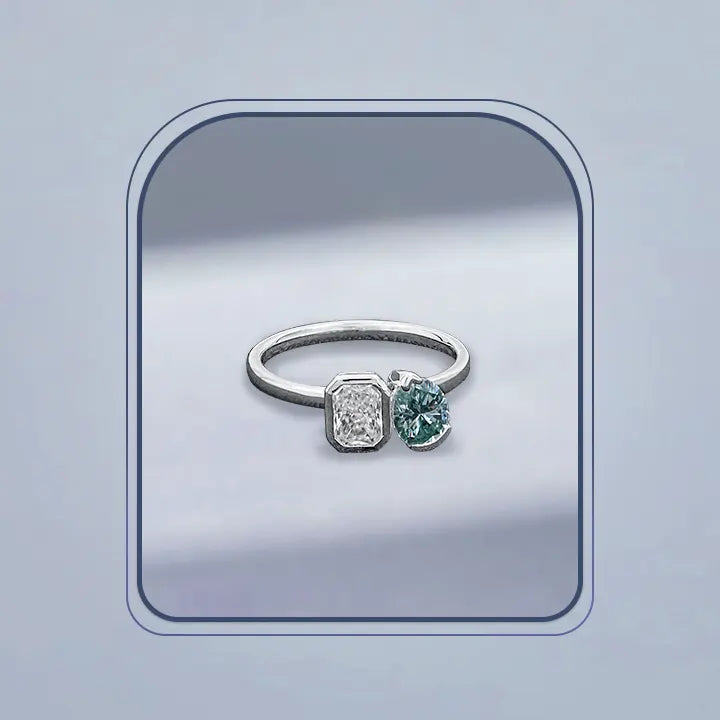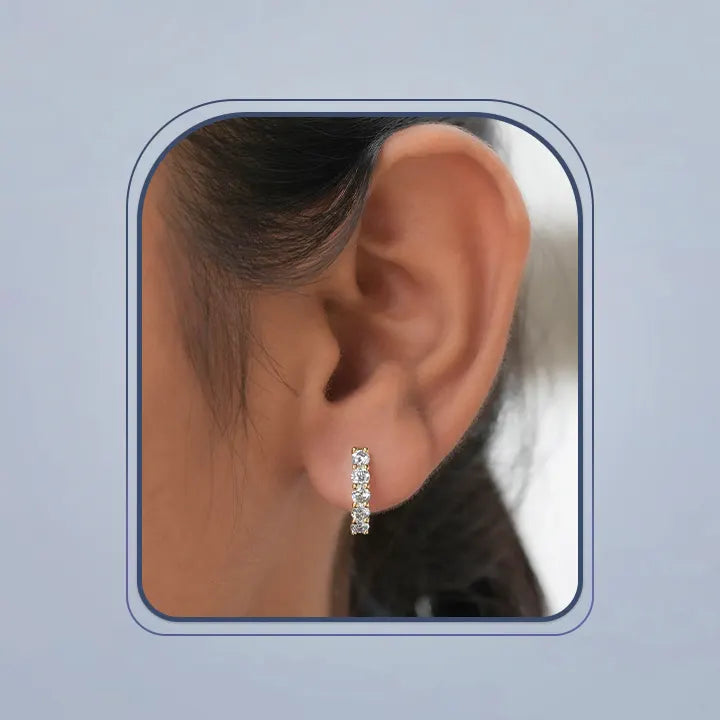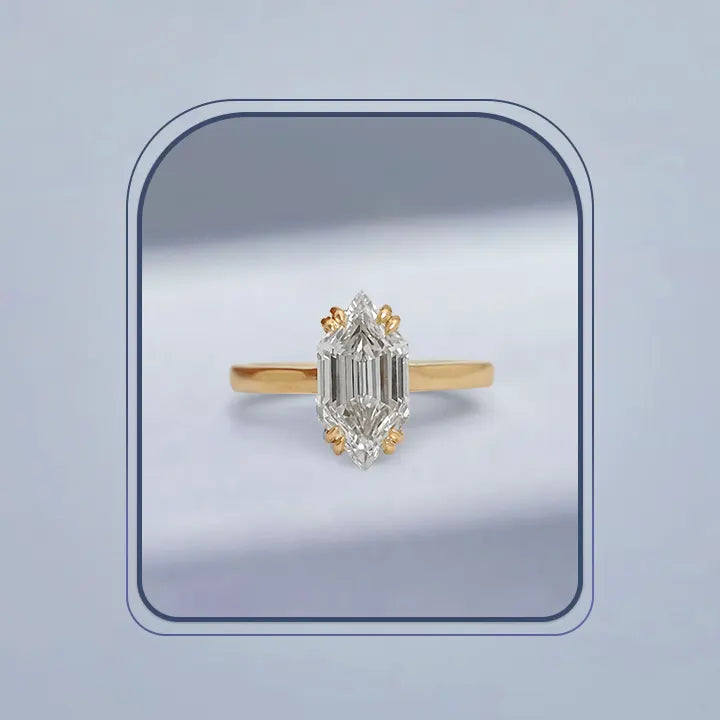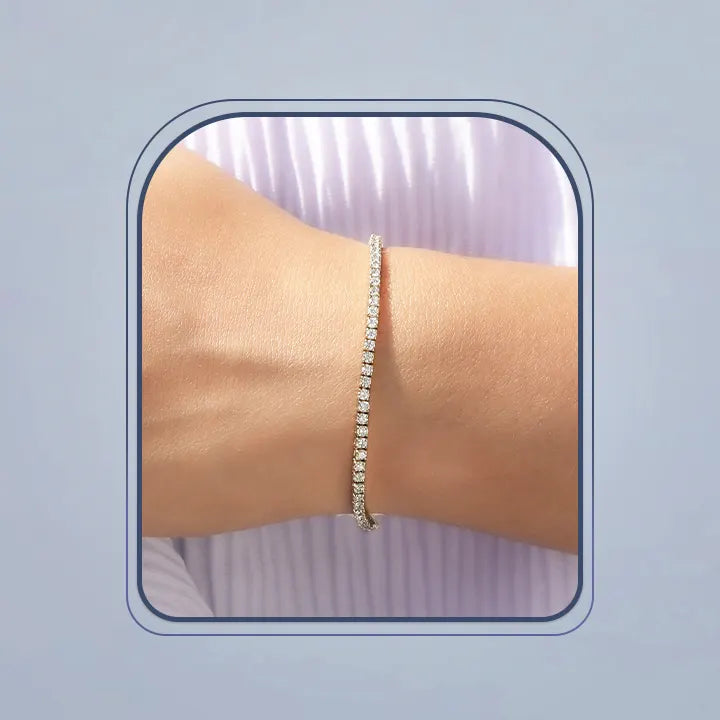Moissanite vs Diamond: Which is perfect for you
Moissanite or diamond?
Absolutely right you are! Whenever we think of buying any jewelry, many questions come to our mind:
"Diamond is the truth; it is the best."
"No, diamonds will become very expensive. Why don't I take Moissanite?"
"No, moissanite will look cheaper; will it look good?"
"It is not durable, whereas diamond is forever."
It is normal to have confusion among these questions, and it is necessary to make the right decision keeping all these aspects in mind.
Till a few years ago, we had no other option than diamonds, so there was less confusion. It was a good thing, but also a bad thing that there was no money left. Diamonds are expensive, so not everyone could buy them.
But today, the world has changed. Whatever natural things are now being prepared artificially, alternatives are being found in everything so that human life can be made more convenient and sustainable. The same is the case with diamonds. Its diamond-like appearance has come, whose name is Moissanite.
More choices means more confusion. Today we are going to solve your confusion. In this article, we will discuss few necessary things about these stones and try to find the perfect one for you and your perticular ocassion.
Table of Contents
▼Moissanite vs Diamond: Key Differences
Choosing between moissanite and diamond is like picking one out of a two twins brothers.
It is natural for us to compare whenever we are about to buy something new, important, and dear to us—something we've been planning to buy for a long time. We tend to weigh the options carefully.
For instance, if we're looking to buy a TV, we compare the specifications of models from different brands. We then select the one that meets our needs: the TV that offers good features for a lower price, or perhaps a slightly more expensive option that provides even better features. This is a common approach we take before making most purchases.
If you want to know which of these two will be suitable for you, then first you have to know about them -Their characteristics, history, and much more.
What is a Diamond?
A diamond is a precious gemstone. Earth's diverse landscapes shape it through gradual geological processes. Obtaining it requires a lengthy and costly mining process.
Characteristics of Diamonds
Composition
Diamonds are made up of carbon atoms organized in a diamond cubic crystal structure.
Hardness
With a Mohs hardness rating of 10, diamonds are the hardest natural material known, making them exceptionally resistant to scratching.
Brilliance
Diamonds have high brilliance due to their excellent ability to refract and reflect light, creating their signature sparkle.
Dispersion
Diamonds exhibit moderate dispersion, which produces colorful flashes of light called "fire."
Durability
They are extremely durable and ideal for everyday wear, making them a popular choice for engagement rings and other jewelry.
Clarity
Diamonds are graded based on the presence of internal flaws (inclusions) and external blemishes, which affect their transparency and value.
Color
Diamonds come in a range of colors from colorless to shades of yellow or brown. Rare diamonds can also be found in colors like blue, pink, and green.
Cost
Generally, diamonds are more expensive than most other gemstones due to their rarity, especially for high-quality stones.
Origin
Diamonds can be either naturally mined or lab-grown. Lab-grown diamonds provide a more ethical and eco-friendly alternative to mined diamonds.
What is Moissanaite?
Moissanite is a gemstone made of silicon carbide (SiC). It was first discovered in 1893 by French chemist Henri Moissan in a meteor crater, and it is named after him. Naturally occurring moissanite is extremely rare, so most moissanite used in jewelry is created in laboratories.
Characteristics of Moissanaite
Hardness:
Measures 9.25 on the Mohs scale, making it the second hardest gemstone after diamonds.
Brilliance:
Exhibits greater brilliance than diamonds due to its higher refractive index, resulting in more sparkle and fire.
Dispersion:
Has a high dispersion rate (fire), creating a rainbow-like effect when exposed to light.
Durability:
Extremely durable and resistant to scratching and breaking, suitable for daily wear.
Clarity:
Typically has fewer inclusions and blemishes compared to natural diamonds.
Color:
Often colorless or near-colorless but can exhibit a slight yellow or grayish tint in certain lighting.
Cost:
Generally more affordable than diamonds, making it a popular alternative for engagement rings and other jewelry.
Ethical and Eco-Friendly:
Lab-created, which means it has a lower environmental impact and is free from concerns related to mining.
We looked at the differences between the two stones, now coming to the real question of which stone will be perfect for you. However, you also have to find the answer yourself because everyone has their own circumstances. Nevertheless, we can roughly see which stone will be better, depending on the occasion, profession, gender and financial situation.
Determining which one is perfect for Whom and When
Occasions
Engagements and Weddings:
Diamonds are traditionally chosen for engagement rings and wedding bands due to their symbolism of eternal love. Their classic appeal makes them a popular choice. However, moissanite is gaining popularity for these occasions because it offers stunning look, available in different and decent colors that allows you to customize according to you choosen theme with being durable that can be wore for longer time, allowing couples to get a high-quality ring without the high price tag.
Anniversaries and Milestone Celebrations:
Diamonds are often given to celebrate significant milestones, reflecting the enduring nature of a relationship. For a luxurious gift that’s more budget-friendly or ethically sourced, moissanite is a fantastic alternative that still provides exceptional sparkle and beauty.
Everyday Wear and Casual Events:
Moissanite is ideal for everyday wear and casual events. Its durability and resistance to scratches make it a practical choice for pieces like earrings, bracelets, and pendants worn daily. While diamonds are also suitable for everyday wear, moissanite offers a cost-effective option without compromising on style.
Formal Events and Special Occasions:
Diamonds are considered the go-to gemstone for formal events, adding a touch of luxury and sophistication. A diamond necklace or earrings can elevate any formal outfit. Moissanite has a great sparkle. It can shine at any event. It gives a glamorous look, equal to a diamond but at a lower cost.
Must visit- Our glamorous collection of Moissanite Necklaces
Profession
Corporate and Business Professionals:
Diamonds symbolize success and status. So, they are popular with corporate professionals who want to appear elegant. Subtle diamond jewelry, like stud earrings or small pendants, adds sophistication. It does so without being flashy. Moissanite also matches diamonds in style and sophistication. It's cheaper, more elegant, and stylish. So, it's a better choice for professionals who value beauty and money.
Creative Fields:
Individuals in creative fields such as art, fashion, or entertainment might prefer moissanite for its unique sparkle and standout quality. Moissanite’s versatility allows for more creative and bold jewelry designs, appealing to those who like to make a statement with their accessories.
Healthcare and Active Professions:
For those in hands-on professions like healthcare, sports, or other active roles, moissanite is a practical choice due to its durability and resistance to damage. A moissanite ring or pendant provides the brilliance of a diamond while being able to withstand daily wear and tear.
Financial Status
High Budget:
Those with a higher budget may prefer diamonds for their luxury, rarity, and traditional appeal. Diamonds also offer excellent value retention, making them a good long-term investment. However, those with a high budget who are ethically conscious might still choose moissanite for its lower environmental impact.
Moderate Budget:
Moissanite is perfect for those with a moderate budget. It provides the look and brilliance of a diamond at a fraction of the cost, allowing for larger stones or more elaborate designs without exceeding your budget.
Limited Budget:
For those on a tighter budget, moissanite is an excellent choice. It allows you to enjoy beauty and sparkle similar to diamonds without a significant financial investment. This makes moissanite a popular option for young couples, students, or anyone looking to maximize their budget while still getting quality and style.
Conclusion
Choosing between moissanite and diamond depends on your individual preferences and needs. Diamonds are celebrated for their timeless elegance, durability, and prestige, making them ideal for major milestones and higher budgets. Moissanite, however, provides exceptional brilliance and durability at a more affordable price, offering a great alternative for those seeking a cost-effective and ethical option.
For special occasions like engagements and weddings, diamonds represent classic luxury, but moissanite is gaining popularity for its stunning sparkle and lower cost. In everyday wear and casual settings, moissanite's practicality and style make it a practical choice, while diamonds remain a symbol of luxury and status.
Ultimately, your decision should reflect your budget, the occasion, and personal values. Whether you opt for the traditional charm of diamonds or the brilliant affordability of moissanite, both offer unique advantages to meet your needs.
FAQs
Is moissanite a fake diamond?
No, moissanite is not a diamond. Moissanite is made of silicon carbide whereas diamonds are made of carbon. Although moissanite looks like a diamond in an ideal extent about brilliance and durability
Does moissanite pass diamond tester?
Moissanite can pass some diamond testers but this most of the times proves to be a false result since traditional diamond testers measure the heat conductivity of stones and moissanite possesses comparatively similar heat conductivity as diamond, thus it can pass as a diamond.

.png?v=74971505631319126241739980080)

.png?v=170379015109479064061739980109)
 Solitaire Ring
Solitaire Ring
 Accent Ring
Accent Ring
 Halo Ring
Halo Ring
 Bridal Set
Bridal Set
 Toi-Moi Rings
Toi-Moi Rings
 Three Stone Ring
Three Stone Ring
 Vintage Ring
Vintage Ring
 Bezel Set
Bezel Set
 Channel Set
Channel Set
 Dainty Band
Dainty Band
 Eternity Band
Eternity Band
 Studs and Earrings
Studs and Earrings
 Bracelet
Bracelet
 Necklace
Necklace
 Men's jewelry
Men's jewelry
 Brilliant
Brilliant
 Old Cut
Old Cut
 Step Cut
Step Cut
 Matching Pair
Matching Pair


 Five Stone Ring
Five Stone Ring
 Pave band
Pave band


![[Moissanite vs Diamond : Comparison of a sparkling round-cut diamond ring on a wooden surface.]-[golden bird jewels]](http://www.goldenbirdjewels.com/cdn/shop/articles/3_moissanite_vs_diamond_which_is_perfect_for_you_2000X1000_38892358-71f8-4a32-93b3-9d061a597091.webp?v=1731672176&width=5000)









![[Which hand to wear a promise ring]-[Goldenbird Jewels]](http://www.goldenbirdjewels.com/cdn/shop/articles/Which_hand_to_wear_a_promise_ring_1024x1024.webp?v=1735388893)
![[How To Care For Your Moissanite Engagement Ring]-[Goldenbird Jewels]](http://www.goldenbirdjewels.com/cdn/shop/articles/banner_image_1_1024x1024.jpg?v=1735364626)


